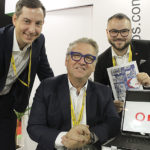The German company with its long history of making pioneering high-chem specialty inks has a comprehensive range of printing and color coding inks for cables and optical fibers, suitable for a variety of substrates. Herkula has been serving the Indian cable and OFC market for over 20 years and desires to fast-track its growth in the next 5 years through introducing some game-changing printing chemistries. Its newest ink for inkjet printing has already received a universal market approval.
Excerpts of Wire & Cable India’s interview with Mr. Ricardo Ilges, Senior Marketing Manager, FARBWERKE HERKULA SA/AG:

Mr. Jonas Malige, Marketing Manager, FARBWERKE HERKULA SA/AG
Wire & Cable India: Tell us briefly about the Herkula and when was the company founded? How many years have you been in India?
Ricardo Ilges: Herkula, a family owned company, was founded in the year 1894 in Krefeld, Germany. Mr. Bodo Franke (Junior) took over the company in the early 1960s. After his demise in 2012, the company is now fully owned by the charitable foundation ‘Stiftung Bodo und Jutta Franke Deutschland’.
In the year 1894, we started our business with several products and from 1970 we started catering to the cable market with our solvent-based marking inks for copper cables. In the early 1980s, the industrial production of optical fiber cables came up. Subsequently, together with Siemens and Corning, we started developing UV-curable inks to color optical fibers. Now, we also specialize in producing UV-curing inks for matrix material products, i.e. tight buffer materials like ribbon, CFU, micro-modules, etc. Herkula focuses a lot on the development of special products characterized with flame-retardant, high temperature and water barrier properties. Apart from catering to the cable industry, we are also present in other business sectors.
Our solvent-based gravure printing ink to mark the cables or ring marking is an old business unit. The newest product developed by Herkula is inkjet ink. All the inkjet printer suppliers specialize in the technology part of the printers but the ink part is Herkula’s specialty. Inkjet printer manufacturers often complain about the poor quality inks with very bad adhesions, especially on tricky substrates like XLPE. It is vital for the customer to have reliable and quality inks for better adhesion. The maintenance of the printer and service also need to be taken into consideration as most of the times production is stopped as the inkjet ink gets stuck in the system. Our inkjet ink perfectly addresses all those problems, and we get lots of inquiries for this new product.
WCI: Tell us more about Herkula’s product range!
RI: As mentioned earlier, we have our new product which is inkjet ink. The old product range includes solvent-based ink to mark cables via gravure. Our focus has always been to provide customers ink for all kinds of substrates. We supply specially adapted products according to different substrates in combination for all kinds of speeds — from 100 m/min up to 1200 m/min when we talk about solvent-based ink and marking via gravure printing. For the ring marking too, the speed range is the same. We can provide solutions even for the production speed starting from 400-500 m/min up to 2400 m/min.
We also have UV optical fiber ink for machines with production speed of 3000 m/min. We are hoping that machine supplier can provide a quicker version of printer because our ink works just fine at the speed of 3000 m/min.
Herkula also provides all kinds of matrix materials for building up ribbon of 4 fibers, 6 fibers, 8 fibers and 12 fibers. The ribbon material is same as the CFUs (compact fiber units) and we provide matrix material for whatever kind of CFU one wants to build up, be it 2 fibers or 8 fibers or more. If the customer wants to build a CFU with jelly inside, we have tight buffer materials to buffer fibers within specifications up to 900 micron. There is one optical fiber inside the buffer and this is a specific kind of buffering. All these products we have come in various versions that include flame retardant, high temperature, and other properties.
WCI: You have a variety of coloring materials for different substrates such as PE, PP, and PVC. Is it not possible to use one universal coloring material or ink for PE, PP or PVC?
RI: Yes. One ink can be used for PE, PP or PVC but then coloring needs to stay at a very low speed. We need to support customers with varying degree productivity and speeds. For example, for ring marking, when we talk about the highest speed, we are talking about 2400 m/min. And then unfortunately the ink system needs to be adjusted to the substrate. There are several substrates for one grade but we cannot provide one grade for all substrates. With higher speeds and different absorption capacity of substrates, the priority always remain how fast the ink dries without being washed off or without mopped. The ink needs to dry within a second as soon as it comes out of the extruder and ring marking, and before it moves to the water cooling.
The coloring outcome will be different for different materials. Depending on the substrate and coloring outcome, different kinds of coloring grades are used. There is chemistry behind all of these, for example, PVC is much easier to color than XLPE. It is not possible to have just one grade. Our laboratory is always working to combine as much as possible but at a certain points there are differences.
WCI: In the showcase, I can see some copper wires with fine printing on it. Can the ink be used on metals too?
RI: Those copper wires you are looking at are to just give an example that our new inkjet ink also works on copper. You cannot rub it off but you can scrape it off using some sharp object. The adhesion in the ink is very good to the copper and it is highly demanded product in the industry. This is kind of niche product as small and medium sized copper cable manufacturers do not mark the cables. Only big players demand this ink to mark their copper wires.
WCI: For how many years have you been in India? Tell us some of your experiences!
RI: I have been with Herkula for almost three and a half years now and visit India once in a quarter. Talking about our presence in the Indian market, Herkula has been here when the fiber industry began developing in the early ’80s. We are supplying solvent-based and UV inks to India since those times.
The experience so far has been very good for us and we have seen ourselves growing in terms of sales and business, especially from the last ten years.
WCI: How challenging do you find the Indian market?
RI: The major challenge is delivering the solvent-based inks in the country as it is a dangerous good. It is not easy for the customers to import the solvent-based inks as there are certain restrictions. However, importing UV inks is much easier as it does not comes into high-risk and hazardous category.
India is a market where fight between Europe and China is taking place when it comes to business. Convincing the customers to purchase our products at quoted price is always a challenge. We ensure to convince the customers with our qualitative approach and product reliability.
WCI: Herkula has spent time enough to give us a perspective on the growth of the wire and cable industry. What do you say?
RI: We have our Indian representative, SIMCO Materials International, to support us here in our business activities and sales. India is growing in terms of business opportunities for suppliers like us. In the next five years, we expect to touch 50 percent growth rate in India but at the same time tackling the Asian suppliers would be a challenge for us.
The entire Indian market is growing, especially the fiber market. Even the companies are sending us enquiries if we are providing fibers as well. We believe that even if India could build 20 more drawing towers, the demand for fiber will still be there and customers have to wait for the delivery of orders for months. There are only few companies who are building the fiber and as of now most of the fibers are being imported from other countries.
WCI: Any final words for the Indian market?
RI: Herkula does not believe in only selling the products to the customers and forget about it but also provide on-site support if required. We have customers who come with special demands and we ensure to develop products that meet their specific requirements. The growth of Herkula depends upon the growth of the Indian market.




